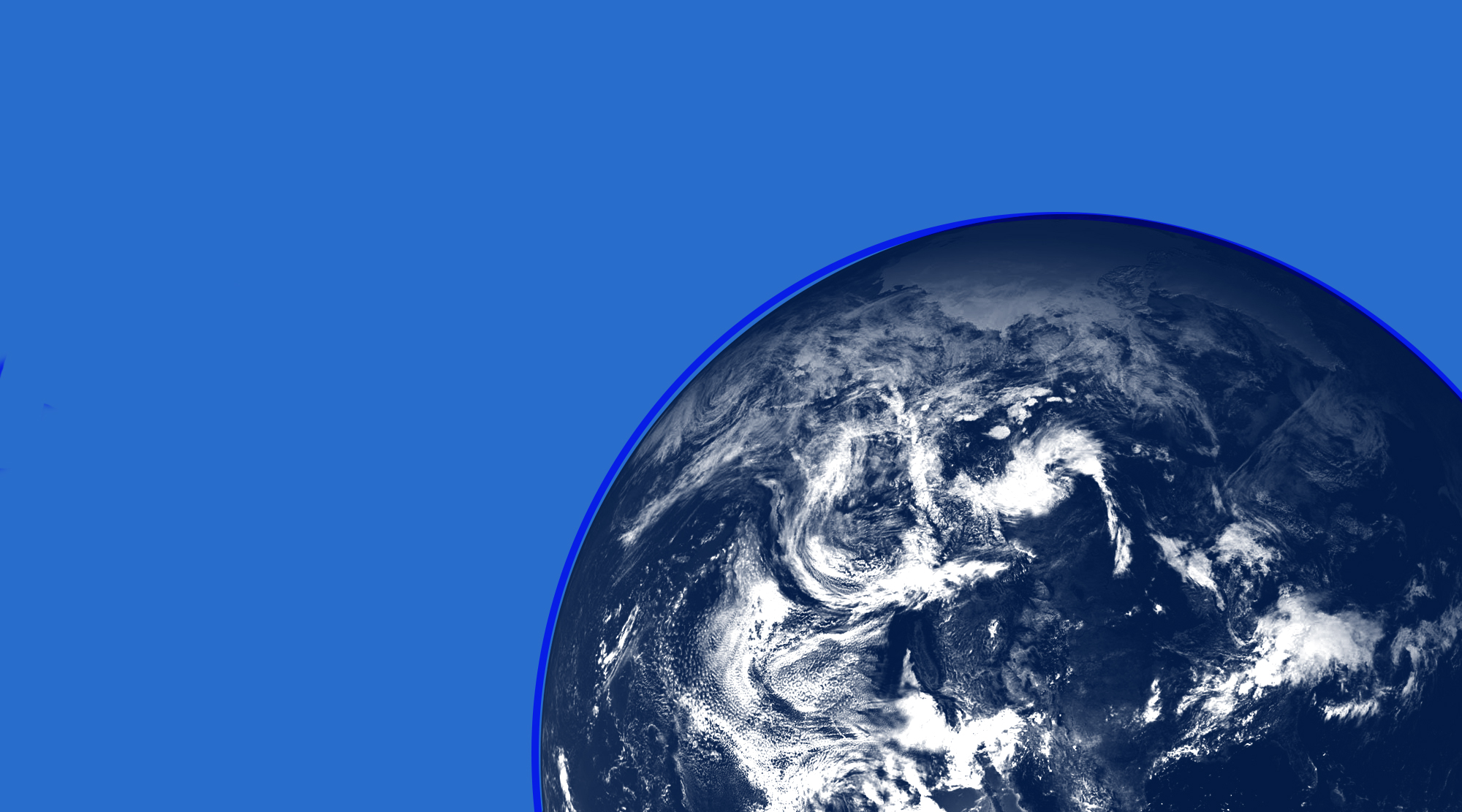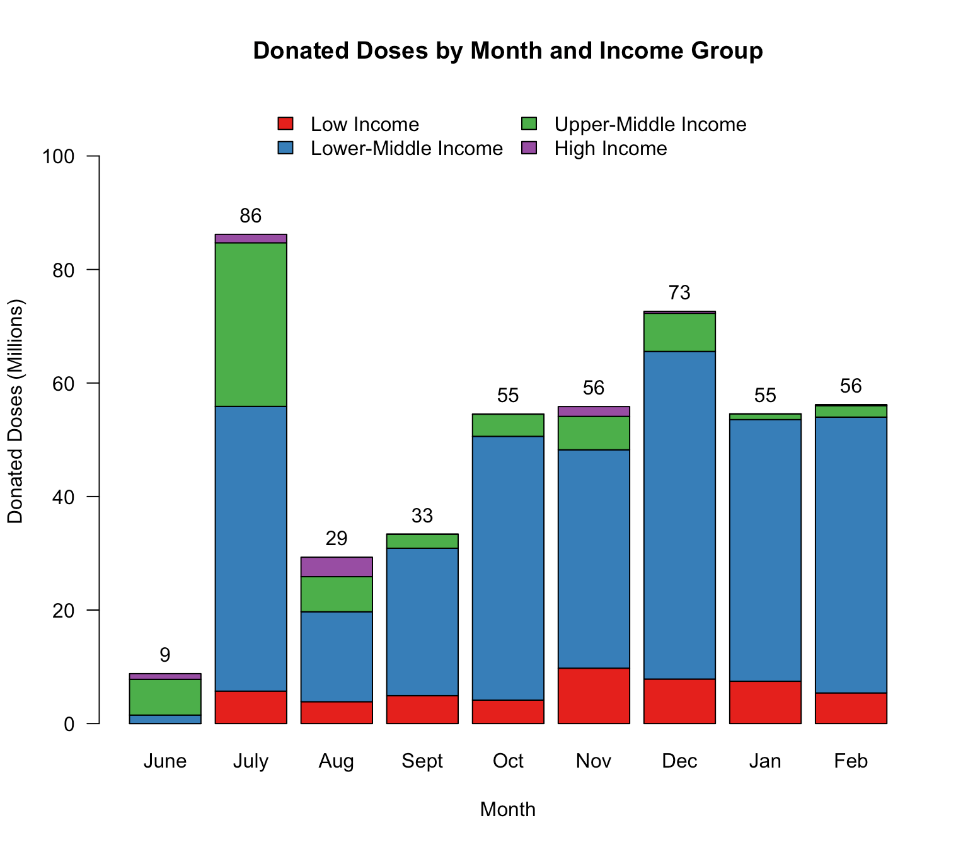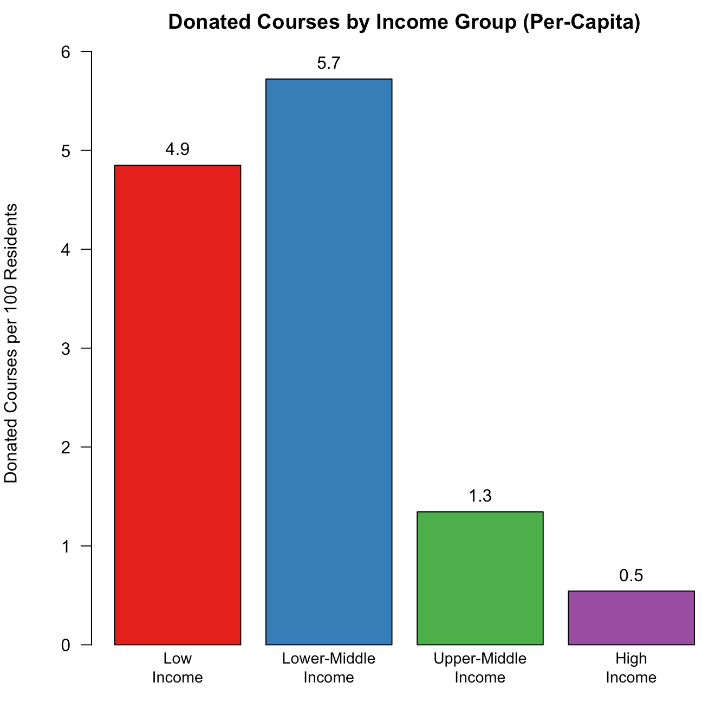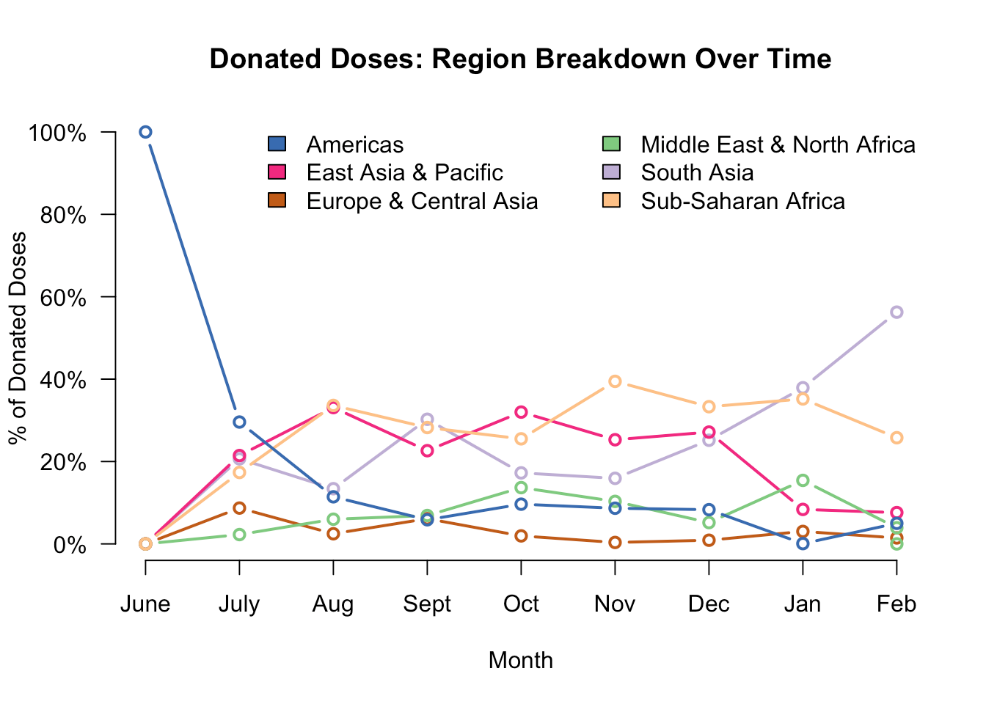
An Incomplete Arsenal
By Zain Rizvi, Jo Walker
Last September, when President Biden announced that the U.S. would purchase another 500 million doses of the Pfizer vaccine for international donation, he called it a “historic commitment.”[1] “This is another half a billion doses that will all be shipped by this time next year,” he said. Taken together with other pledges, the United States committed to shipping 1.1 billion doses of coronavirus vaccine by the end of September 2022.[2]
That original goal will likely not be met—absent a surge of funding and political support for global vaccinations. By the end of February, the U.S. had shipped 474 million doses, donating doses at a rate of 60 million in recent months.[3] To meet the 1.1 billion dose target, the U.S. would have to donate 626 million doses in 7 months, or about 90 million doses per month. That would require increasing the donation rate by 50 percent.
Nearly all U.S. donations now go through COVAX. Its records seem to provide further evidence that the U.S. is not on track to meet the original target. After the additional Pfizer purchase, a senior administration official said that “from January through September of next year, we will ship out 800 million vaccines to the world.”[4] But according to allocation documents, COVAX appears to be expecting 500 million U.S. donated Pfizer doses this year through September. The timing for the remaining 300 million doses remains unclear.[5]

Note: The monthly donations do not add up to the total U.S. donations (474 million) because the U.S. State Department website does not contain detailed records for 22 million doses.
Last month, the U.S. government announced what appeared to be a revised goal of donating 1.2 billion doses by the end of the year.[6] But that goal is also unlikely to be met. To meet the 1.2 billion dose target, the U.S. would have to donate 726 million doses in 10 months, or about 73 million doses per month. That is significantly higher than U.S. reported donations for January (55 million), and February (56 million). Perhaps acknowledging this trajectory, the new COVID-19 preparedness plan released by the Biden administration last week touts the 1.2 billion dose target but does not specify any timelines.[7]
Vaccine donations have not ramped up as expected. After a brief spike in December, donations in January and February lagged behind the required pace. The reason for the delay is unclear. But it comes after a POLITICO story in June reported that the Biden administration had used more than a billion dollars intended to assist countries with vaccine distribution to pay for Pfizer vaccines.[8] More delays may be coming. In December, officials at the U.S. Agency for International Development warned that they were running out of money to support distribution, and that the vaccination campaign could stall in the spring if the administration did not find additional sources of funding.[9] “Without more money, the vaccination campaign will begin to slow significantly,” one official said.[10]
Under-vaccinated countries may require resources to ensure adequate “last mile” delivery of vaccines, or to support effective public health messaging and frontline healthcare workers. But the Biden administration has not provided resources at the scale required. The U.S. has committed just $1.7 billion to vaccine readiness, and a new Global Action Plan provides few details about concrete commitments.[11] The White House recently requested new funding from Congress, but its initial proposal is billions of dollars short of what agencies have said they need, and narrowly focused on distribution of existing doses instead of expanding global manufacturing of the best vaccines. [12]
Meanwhile, nearly 90 countries are not on track to meet the global target of vaccinating 70% of their population—a target endorsed by President Biden.[13] “At the rate we’re going, we are well below our target,” admitted Secretary of State Tony Blinken.[14] The challenges are not uniform. While delivery challenges may slow some donations, supply of vaccines remains a concern in others. In February, the head of the World Health Organization noted that “in many countries, the issues are not primarily a problem of absorptive capacity.”[15]
A comprehensive global strategy would aim to address the twin challenges of expanding delivery and manufacturing. Researchers have previously estimated reaching unvaccinated populations in the developing world with two mRNA doses would require 5 billion doses, while three-doses would require 8.7 billion doses.[16] Airfinity estimates that two-thirds of the expected mRNA supply for this year has already been purchased.[17]
President Biden promised a war time effort against the virus. “We’re not going to solve this crisis with half-measures or middle-of-the-road ambitions. We need to go big. And we need to do our part: governments, the private sector, civil society leaders, philanthropists. This is an all-hands-on-deck crisis.”[18] But a narrow reliance on donations, without a larger strategy on delivery and manufacturing, has undermined the global vaccination effort. The Biden administration can move forward by rapidly requesting additional funding from Congress to make ambitious investments in delivery and manufacturing. One million lives may be at stake.[19]
Appendix
Other findings:
- The U.S. State Department website does not fully reflect the scope of U.S. vaccine donations.[20] According to the website, the U.S. had shipped 474 million doses, but we could only identify records of 456 million doses in the country-by-country breakdown. Our analysis is limited as a result.[21]
- The highest number of donations (86 million doses, 54 million courses) were made in July 2021. After July, monthly donations gradually rose between August and December 2021, but fell dramatically in January 2022.

- The surge of donations in July suggests that the U.S. had accumulated a significant stockpile of unused doses that could have been shared earlier.
- On a per capita basis, lower-middle income countries have received more vaccines than other income groups.[22]

- The geographic focus of U.S donations has shifted away from the Americas (which received all donations made in June, and more doses than any other region in July) and towards other regions over time, particularly South Asia and Sub-Saharan Africa.

- Despite its crushing Delta wave in May 2021, India was not listed as a beneficiary of U.S. vaccine donations on the U.S. State Department or the UNICEF website. Earlier reports had identified vaccine indemnification requirements as holding up donations.[23]
References
[1] https://tinyurl.com/mtv2mfyf
[2] The 1.1 billion dose timeline comes from the two 500 million dose Pfizer purchases, and the initial donation from US supply in June 2021. The US committed to allocating 80 million doses by June 2021. https://tinyurl.com/fkswbzsy Then, the US committed to sending the first 500 million doses Pfizer purchased by the first half of 2022. https://tinyurl.com/48cx2za8 . Finally, at the September summit, President Biden announced new commitments “to supply an additional 500 million doses of Pfizer vaccine that will all be shipped by this time next year.” https://tinyurl.com/2p8fj5wc. See also, Senior administration official: “And that means from January through September of next year, we will ship out 800 million vaccines to the world.” https://tinyurl.com/2p8n76fy
[3] Recent months reflects the average donations from October 2021 through February 2022. We note that there is a discrepancy between what the State Department website reports the U.S. has 1) donated in aggregate and 2) what the U.S. has donated on a country-by-country level, per shipment. We rely on publicly available data to derive monthly totals, so we were unable to identify when 22 million doses were shipped. https://www.state.gov/covid-19-recovery/vaccine-deliveries/
[4] https://tinyurl.com/2p8n76fy
[5] https://www.who.int/publications/m/item/decision-of-the-independent-allocation-of-vaccines-group-on-the-allocation-of-covax-facility-secured-vaccines-27-january-2022 (“The JAT was informed by the COVAX Pfizer Task Team of the need to allocate around 320 million USG-facilitated Pfizer doses for intended delivery from March-September 2022. These doses come in addition to the nearly 180 million Pfizer doses already allocated during the course of 2021 and covering shipments through March 2022. The USG provided a guaranteed and scheduled supply of 500 million Pfizer doses in 2022, with 300 million additional doses expected to be made available for the Facility to obtain through a facilitated procurement.”)
[6] Tony Blinken in December 2021: “We’re on track to meet our goal of donating 1.2 billion doses by next fall.” https://www.state.gov/secretary-antony-j-blinken-at-a-virtual-panel-discussion-on-bolstering-democratic-resilience-building-back-better-together-from-covid-19/. Tony Blinken in February 2022: “To date, we’ve delivered over 435 million safe, effective vaccines free of charge with no political strings attached as part of our overall commitment to donate 1.2 billion doses by the end of the year.” See also, https://www.usaid.gov/news-information/press-releases/feb-17-2022-new-case-studies-show-significant-rise-vaccination-rates-sub-saharan-africa
[7] https://www.whitehouse.gov/covidplan/
[8] https://www.politico.com/news/2021/07/21/global-vaccine-effort-usaid-cash-500342
[9] https://www.politico.com/news/2021/12/27/biden-covid-vaccines-usaid-funding-526126
[10] https://www.politico.com/news/2021/12/27/biden-covid-vaccines-usaid-funding-526126
[11] https://www.state.gov/secretary-antony-j-blinken-at-a-virtual-covid-19-global-action-meeting/ and https://www.usaid.gov/news-information/press-releases/feb-17-2022-new-case-studies-show-significant-rise-vaccination-rates-sub-saharan-africa
[12] https://www.whitehouse.gov/wp-content/uploads/2022/03/COVID-and-Ukraine-Supplemental-Funding-Request-Pelosi.pdf
[13] https://www.state.gov/secretary-antony-j-blinken-at-a-virtual-covid-19-global-action-meeting/
[14] https://www.state.gov/secretary-antony-j-blinken-at-a-virtual-covid-19-global-action-meeting/
[15] https://tinyurl.com/nhafp7mw
[16] https://www.medrxiv.org/content/10.1101/2022.02.08.22270465v1
[17] Airfinity, January weekly briefing.
[18] https://www.whitehouse.gov/briefing-room/speeches-remarks/2021/09/22/remarks-by-president-biden-at-virtual-global-covid-19-summit/
[19] https://www.medrxiv.org/content/10.1101/2022.02.08.22270465v1
[20] https://www.state.gov/covid-19-recovery/vaccine-deliveries/
[21] The UNICEF website contains more information about doses donated by the U.S. government, but it does not include when the doses were donated. https://www.unicef.org/supply/covid-19-vaccine-market-dashboard
[22] This chart reflects donated courses among income groups, divided by total population in those income groups, including countries that did not receive doses. The U.S. has not made clear what criteria it uses for distribution. However, vaccine allocation may reflect the age structure of these countries, in addition to vaccination coverage and absorptive capacity. Low-income countries have lower vaccination rates than lower-middle income countries, but lower-middle income countries have more at-risk populations (e.g., more people aged 60+) per capita than low-income countries. https://pandem-ic.com/in-this-age-discriminating-pandemic-demography-still-rules/
[23] https://www.reuters.com/world/india/legal-wrangles-hold-up-us-vaccine-donations-india-2021-07-28/